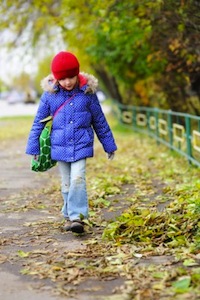Seasonal Affective Disorder, or SAD as it is commonly known, is described here, as well as common signs and possible treatments for those winter blues.
What is Seasonal Affective Disorder – SAD?
Seasonal Affective Disorder (SAD), or the winter blues, is a recognised mood disorder that affects people during the winter months. This type of depression is caused by a lack of sunlight and is particularly prevalent in countries where winter days are extremely short and winter nights are long.
The disorder generally develops in adulthood, is more common in women and relatively uncommon in people aged under 20. However some children and teenagers can be affected.
SAD is currently being popularised on the TV show Men in Trees which features an Alaskan policewoman spending part of each day in front of her light box to help combat the depressive disorder.
There have also been particular concerns raised in New Zealand recently, about our children not getting enough sunshine and hence developing vitamin D deficiency as well as symptoms of SAD. This is being caused by children spending too much time indoors, wearing long sleeved “hoodies” outside, and by some parents being overzealous in protecting their children from the damaging effects of the sun.
A range of physical and emotional problems characterises SAD, including trouble sleeping, being depressed and anxious, craving sweets and carbohydrates and mood changes. It can mimic clinical depression and be quite severe in some cases. Some sufferers describe the condition as “an energy crisis”.
There also seems to be a family link – many people with SAD have a parent or other close relative with the condition.
Why some people develop this disorder and others do not is not known, but it is linked to the body’s circadian rhythm – the natural body clock that controls energy flow during the day. Possible causes include disruptions in the production of melatonin (the hormone that helps govern sleep) and/or serotonin (a neurotransmitter chemical).
The main form of treatment is increasing the daily intake of light by going outdoors or using artificial means.
SAD was first noted in Scandinavia. It’s been estimated about 20% of Swedes suffer with the problem due to their long, dark winters.
Signs and symptoms of the winter blues
- Oversleeping
- Lethargy
- Depression
- Overeating
- Anxiety
- Irritability
- Craving sweet food and carbohydrates
- Weight gain
- Loss of libido
- Aches and pains
- Headaches
- Mood changes
- Difficulty concentrating
- Social withdrawal
Children with SAD
Many people with SAD believe they had suffered with it since childhood.
Symptoms in childhood appear during the winter months and include:
- A drop in school achievement
- Memory problems
- Difficulty writing and organising thoughts
- Withdrawing from family and friends
- Feeling hyper-elated in the spring – being extremely wakeful and hyperactive at this time of year
Treatment for seasonal affective disorder
- The most common treatment is light therapy – people sit in front of special lamps daily. These special light boxes give around 10 times the intensity of ordinary home lighting and have been shown to be very effective – with up to 85% success rate
- There have been good results from flax and fish liver oils and also supplementation with tryptophan, another natural remedy
- Medication – doctors may prescribe an antidepressant. However, rather than consider such heavy-duty pharmaceuticals, you could firstly try natural mood elevators like St John Wort, which has had good results on SAD. See a good natural health practitioner for help
- Psychotherapy – to help delve into the deeper issues of what’s going on in your life, other than a simple lack of sunlight. See a psychotherapist (who uses a variety of different forms of ‘talk therapy’), rather than a psychiatrist who prescribes pharmaceutical drugs. Some SAD sufferers have had good success with cognitive behaviour therapy.
- Negative Ion Therapy – using an ioniser seems to help many sufferers
Risks & complications of SAD
- SAD sufferers are found to have a lowered immune response which means it’s harder for them to combat infections
- If your child is depressed enough to think or talk about suicide, then they need urgent medical/psychological assistance
What can I do to help the winter blues?
- Check out 5 ways families can battle seasonal affective disorder this Winter
- Encourage your child to exercise regularly – including walking outdoors to increase their sun exposure
- Bring more light into your home – trim back trees, open curtains, install a skylight
- Encourage your child to sit by windows during the winter to increase sun exposure
- Eat a nutritious diet and cut back on caffeine, sugar and refined products
- If you can afford to, take a winter holiday somewhere bright and warm
- Visit a qualified natural practitioner such as naturopath, homeopath, herbalist aromatherapist or Ayurvedic practitioner who can all help. Because conventional treatment is limited, you might need to look outside mainstream medicine for help with SAD
- Supplement your child’s diet with a good multi-mineral including magnesium and multi-vitamin, including the B vitamins. A natural healer is likely to also suggest other supplements and remedies that will be helpful
- Colour therapy is becoming more popular. See an Aura Soma practitioner who will help you bring more colour into your life and addresses the deeper issues behind SAD – you might need more yellows, oranges and reds in your house.
Now that you know more about Seasonal Affective Disorder, check out our articles on Natural therapy as well as our advice on Healthy nutrition for the whole family.







Where can I get one of these sad lamps – I live in Auckland